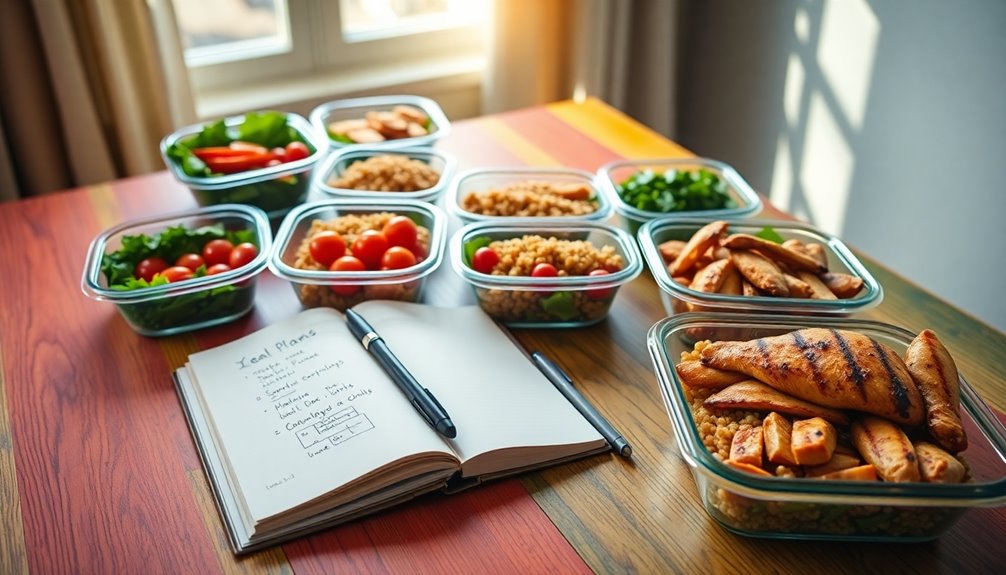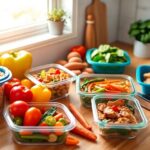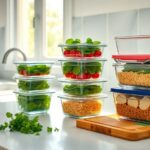To plan balanced meals for the week, start by understanding nutritional basics like portion control and including proteins, fruits, veggies, whole grains, and healthy fats. Choose diverse recipes that suit any dietary restrictions you might have. Next, create a categorized shopping list based on your recipes to streamline grocery trips. Meal prep by cooking in batches and organizing meals in airtight containers for easy storage and reheating. Make sure to track freshness by labeling containers with dates. This way, you'll save time and reduce food waste. There's much more to discover about enhancing your meal planning efficiency.
Key Takeaways
- Review and select a variety of recipes that include proteins, fruits, veggies, whole grains, and healthy fats to ensure balanced meals.
- Create a categorized shopping list based on selected recipes, focusing on budget-friendly and seasonal ingredients to maximize freshness.
- Use batch cooking techniques to prepare multiple meals at once, saving time and reducing the likelihood of food waste.
- Store meals in airtight containers, label them with dates, and freeze portions for convenient reheating and safety.
- Plan for leftovers and ingredient swaps to maintain variety and adapt to dietary preferences throughout the week.
Understand Nutritional Basics

Understanding nutritional basics is essential for planning well-balanced meals that support your health. You'll want to focus on two key components: portion control and macronutrient balance. Mastering these aspects can help you nourish your body effectively while also enjoying your meals.
Portion control is about serving sizes. It's easy to overestimate how much you need, leading to excessive calorie intake. By using tools like measuring cups or a food scale, you can better gauge your portions. Visual cues, like using your hand to estimate serving sizes, can also be helpful.
For instance, a serving of protein should typically be about the size of your palm, while carbs can match the size of your fist. This practice not only helps you maintain a healthy weight but also encourages mindful eating.
Next, consider macronutrient balance, which refers to the right proportions of carbohydrates, proteins, and fats in your diet. A general guideline is to aim for 45-65% of your calories from carbohydrates, 10-35% from protein, and 20-35% from fats. This balance provides the energy and nutrients your body needs to function at its best. Incorporating homemade vegan smoothies into your meal plan can also enhance your nutrient intake while providing a satisfying source of protein.
When you plan meals, think about incorporating a variety of foods that fit these macronutrient categories. This approach not only supports your physical health but also fosters a sense of community as you share meals with others.
Choose Your Recipes
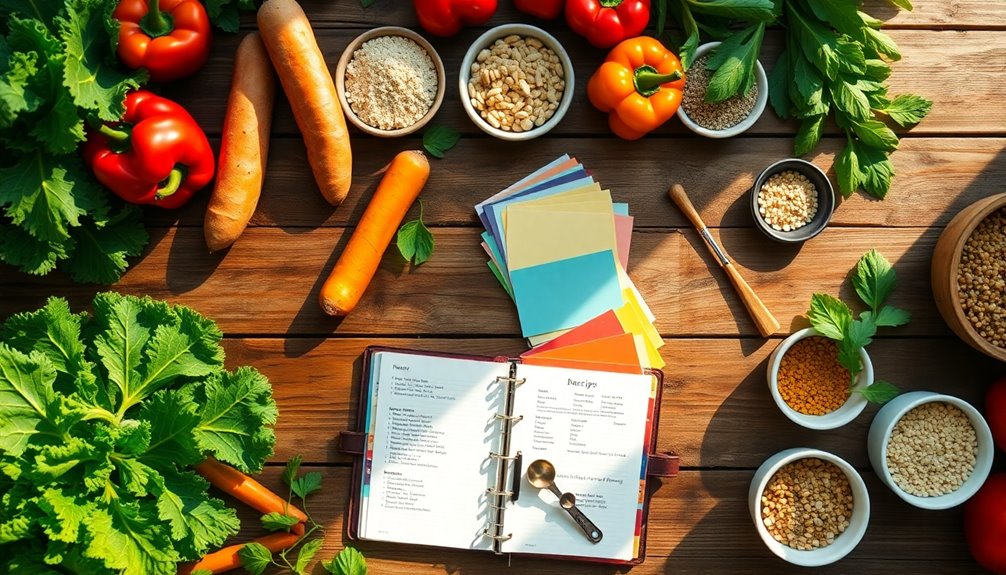
Once you've grasped the basics of portion control and macronutrient balance, it's time to choose your recipes. Selecting a diverse range of meals not only keeps your palate excited but also makes sure you're getting a wide range of nutrients. Aim for recipe variety by including different protein sources, grains, vegetables, and healthy fats throughout the week. This approach helps prevent boredom and encourages you to explore new ingredients and flavors.
When choosing recipes, always consider any dietary restrictions you or your family members may have. Whether it's allergies, intolerances, or specific lifestyle choices like vegetarianism or gluten-free diets, it's important to find recipes that fit those needs. Thankfully, many resources are available to help you adapt traditional dishes. For instance, if someone in your household is lactose intolerant, you can substitute dairy products with plant-based alternatives without sacrificing taste.
To make your meal planning effective, pick recipes that can be prepared in bulk or easily adjusted for different days. This way, you can cook once and enjoy multiple meals, saving time while maintaining a balanced diet. Additionally, a plant-based diet offers significant health benefits, making it a great option for your weekly meal planning.
Don't shy away from experimenting; try new cuisines or cooking methods to keep things interesting. By thoughtfully selecting your recipes, you create an inviting atmosphere around mealtimes, making healthy eating a shared experience that fosters connection and belonging. So, roll up your sleeves, and let your culinary creativity shine!
Create a Shopping List
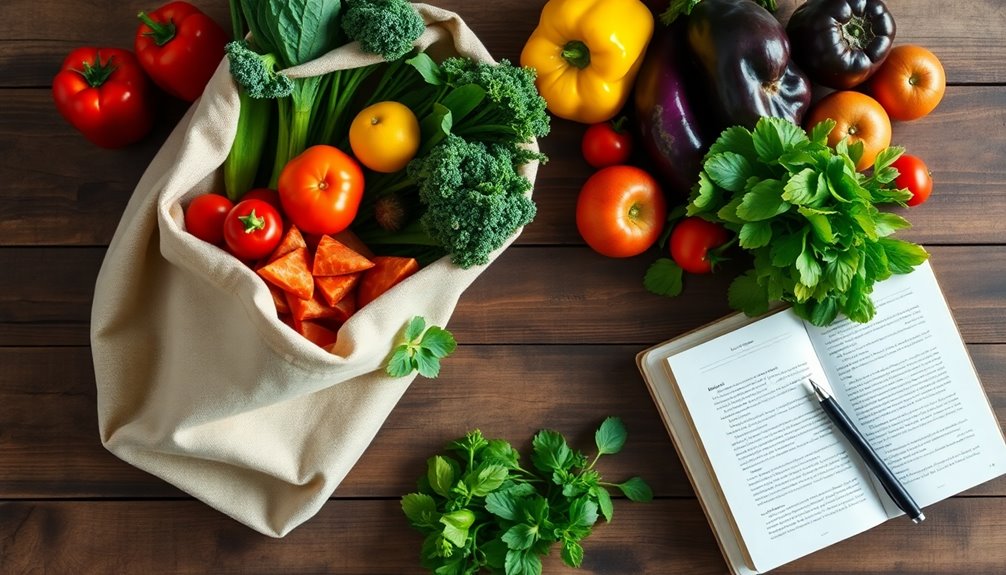
Creating a shopping list is an essential step in your meal planning process, as it guarantees you have everything you need on hand to prepare your chosen recipes. Start by reviewing the recipes you selected, and jot down each ingredient. This method not only keeps you organized but also prevents impulse buys that can derail your budget.
When building your list, be mindful of budget-friendly options. Look for sales or use coupons to save money on staple items. Planning meals around what's on sale can noticeably reduce your grocery bill, while still allowing you to enjoy diverse and nutritious meals.
Incorporating seasonal produce is another great strategy. Fruits and vegetables that are in season tend to be fresher, tastier, and often less costly. For instance, if you're planning meals for the spring, consider including asparagus, strawberries, or peas. Not only do seasonal ingredients enhance the flavor of your dishes, but they also support local farmers, fostering a sense of community.
As you write your list, categorize items by sections of the store—produce, dairy, grains, and proteins. This way, you can navigate the store efficiently, minimizing the time spent shopping. Remember to keep your list handy while shopping, as sticking to it's key to maintaining your budget and ensuring you have everything needed for your meals. Additionally, incorporating plant-based diets into your meal planning can improve your overall health and reduce your environmental impact.
Meal Prep Techniques
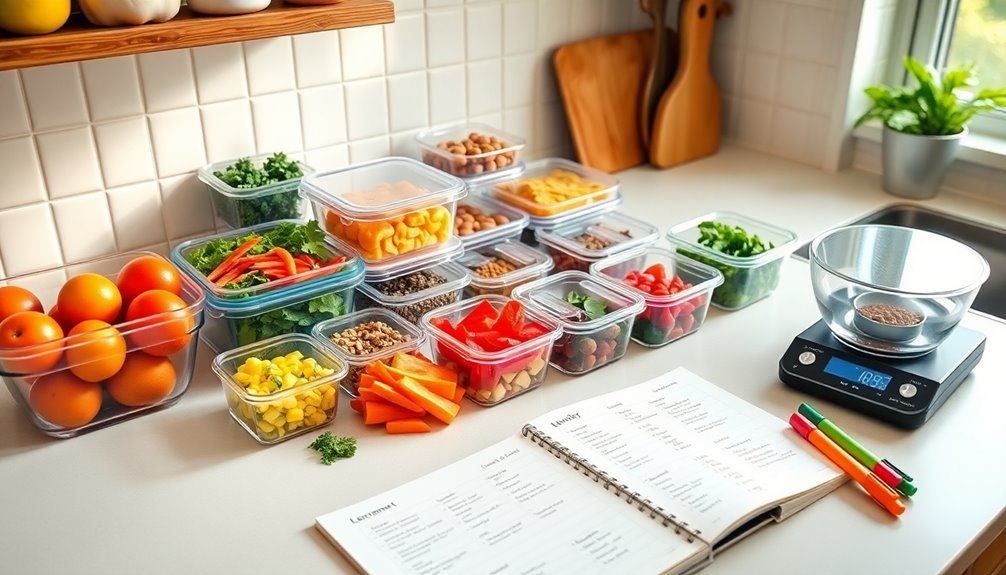
With your shopping list in hand and the right ingredients selected, you can now focus on meal prep techniques that streamline your cooking process. Effective meal prep not only saves you time but also helps you maintain a balanced diet throughout the week. Here are four practical techniques to enhance your time management and efficiency:
- Batch Cooking: Prepare large quantities of staples like grains, proteins, and roasted vegetables. This way, you can mix and match throughout the week, creating diverse meals without extra effort.
- Chop and Store: Spend some time washing, peeling, and cutting your vegetables. Store them in clear containers in your fridge. Having prepped veggies on hand makes it easy to put together a quick stir-fry or salad.
- Use Ingredient Swaps: If you're short on time or certain ingredients, don't hesitate to make exchanges. For example, if you're out of quinoa, brown rice or even lentils can serve as an excellent substitute. This flexibility keeps your meals interesting and ensures you can stick to your plan.
- Plan for Leftovers: When cooking, make a little extra. Transform leftovers into new dishes, like turning roasted chicken into chicken salad or tacos. This not only saves time but also reduces food waste. Additionally, consider following a custom keto diet plan to align your meal prep with your nutritional goals.
Storage and Reheating Tips
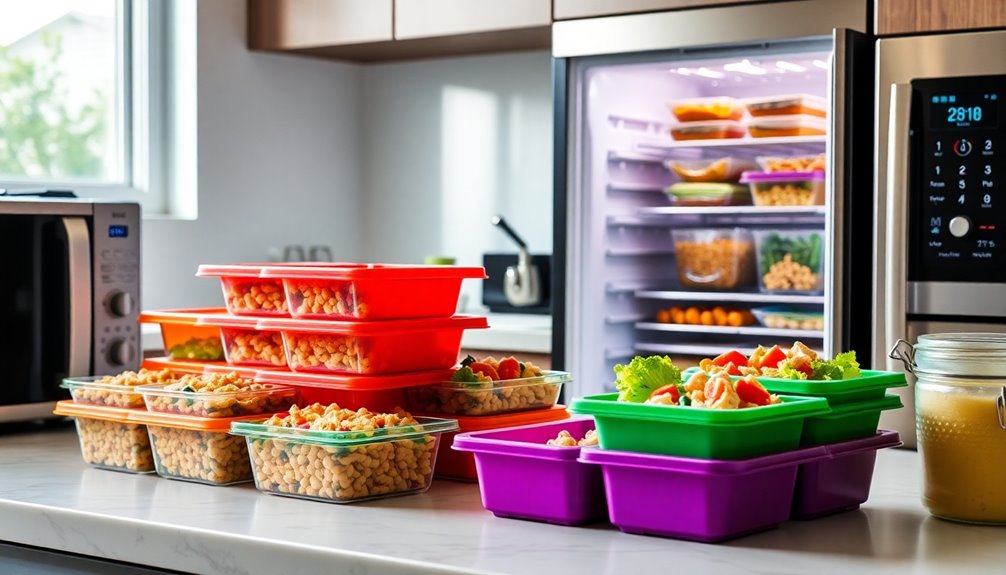
Proper storage and reheating techniques can greatly extend the life of your meal prep and guarantee you enjoy your dishes at their best. To start, make sure you're using airtight containers to keep your meals fresh and safe. Glass or BPA-free plastic containers are ideal, as they help maintain the quality of your food while preventing contamination.
When it comes to food safety, remember to cool your meals before sealing them up. The USDA recommends refrigerating leftovers within two hours to minimize the risk of bacteria growth. Label your containers with dates, so you can keep track of freshness. For longer storage, consider freezing meals in portion-controlled sizes. This way, you can defrost only what you need, reducing waste and keeping your meal plan on track.
Reheating is just as important as storage. Always heat leftovers to an internal temperature of 165°F to make certain that any harmful bacteria are killed. Use the microwave, stovetop, or oven, depending on the dish. Stirring during reheating helps distribute heat evenly, ensuring that every bite is delicious and safe.
Lastly, practice portion control when serving your meals. This not only helps with managing your intake but also allows you to enjoy your meal in a balanced manner. By following these guidelines, you'll be able to savor your meal prep throughout the week, feeling confident that you're practicing good food safety and enjoying your culinary creations. Additionally, consider learning the art of hand sharpening to ensure your kitchen tools are always ready for meal prep.
Frequently Asked Questions
How Do I Adjust Meals for Dietary Restrictions?
To adjust meals for dietary restrictions, start by identifying the specific needs.
For gluten-free options, use quinoa or brown rice instead of traditional grains.
Incorporate low-carb alternatives like zucchini noodles for pasta dishes.
For dairy-free substitutes, try almond or coconut milk in recipes.
If nuts are an issue, explore nut-free recipes using seeds like pumpkin or sunflower.
This way, you guarantee everyone feels included and satisfied at the table.
What Are Some Easy Vegetarian Meal Options?
If you're looking for easy vegetarian meal options, try incorporating meat substitutes like tofu, tempeh, or seitan into your dishes. These ingredients can replace meat in stir-fries, tacos, or curries.
Don't forget about plant-based proteins like lentils, chickpeas, and quinoa; they're versatile and filling. You can whip up hearty salads, soups, or grain bowls with them.
Experimenting with spices and herbs can elevate your meals, making them delicious and satisfying!
How Can I Incorporate More Protein Into My Meals?
Think of your meals as a well-tuned orchestra, where protein's the lead instrument. To incorporate more protein, explore diverse protein sources like beans, lentils, tofu, and quinoa. Use meal prep strategies like batch cooking or pre-portioning snacks to make it easier. Mixing these elements into your weekly menu not only enhances flavor but also guarantees you're getting the nutrients you need, creating a satisfying harmony in your diet that fosters a sense of belonging.
What Are Some Quick Breakfast Ideas for Busy Mornings?
When you're hurrying in the morning, quick breakfasts can save you time and keep you fueled. Try smoothie bowls packed with fruits and yogurt for an invigorating start.
Overnight oats are another easy option; just prep them the night before with your favorite toppings.
If you prefer something savory, whip up breakfast sandwiches with eggs and cheese, or enjoy avocado toast for a satisfying, nutrient-rich meal.
These choices make mornings easier and tastier!
How Do I Handle Leftovers Without Wasting Food?
Leftovers can be like hidden treasures waiting for a creative touch. To handle them without wasting food, think of leftover transformations.
You can turn last night's chili into a zesty soup or mix roasted veggies into a hearty frittata. Embrace creative meal prep by storing leftovers in clear containers, making them easy to grab.
Conclusion
As you set off on your culinary journey, think of meal planning as planting a garden. Each balanced meal is a seed that nourishes your body, leading to vibrant health. By understanding nutrition, choosing delicious recipes, and preparing thoughtfully, you cultivate a flourishing week ahead. Just like a gardener tends to their plants, you'll nurture your well-being with every bite. So grab your tools—your recipes and shopping list—and watch your healthy habits bloom!

